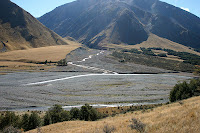What does a geographer do when the real world is too big?
By Lucy Clarke (@DrLucyClarke)
 |
Rivers change due to
the interactions between water, sediment
& vegetation in different environments. Merced River, Yosemite, USA |
 |
An example of a braided
river. The
Waimakariri River, New Zealand
|
 |
An example of an
alluvial fan. Centre
Creek fan, New Zealand
|
Obviously there are a number of factors you have to consider
when you use experimental models, such as: how realistic is the model? What do
the results mean in the real world? And how do you scale the model? The answers
to these vary depending on the research aims of the project in question. To
take the last question as an example, scaling is probably the most important
consideration. Some things in nature cannot be scaled – such as the influence
of gravity or water – but we can control a number of variables used in the
model, like the size of the sediment and the quantity and speed of water
delivered through a river system. Then you have to decide whether you want to
build an exact prototype of a field example (a ‘scaled’ model) which will allow
you to take accurate measurements that can be scaled up to the field site, or instead use a ‘similarity of processes’ model where realistic values are chosen for the model but they don’t relate to a specific field site, instead you observe what happens during the experiment and use this to help improve your general understanding of that landform.
 |
| Experimental channel used to
explore flooding on braided rivers. Run at the TotalEnvironment Simulator (@TotEnvSimulator) at the University of Hull |
I have used both types of model and they each have their own
advantages and disadvantages, but both have generated interesting and useful
results. First of all, I have used scaled models to explore braided river
systems – rivers that have an interconnected network of small channels rather
than one main channel flowing through them. Using an experimental channel 10m
long and 1.5m wide we scaled the sediment size and flow rates to replicate the
Tagliamento River in Italy and explored how different size floods change the
behaviour of the river. This is work that we are currently analysing the data
from so I will hopefully have some results to report in the next year.
A lot of my research has looked at alluvial fans – these are
fan-shaped deposits formed by water and sediment that are often formed where
small streams lead into larger rivers or when rivers enter lakes and other
water bodies. I have used ‘similarity of processes’ models to try to get a
better understanding of the processes operating on these through time and my
recent experiments have used live vegetation (alfalfa) to explore how
vegetation can influence this.
 |
Live vegetation
(alfalfa) being grown on an experimental alluvial fan.
The experimental
plots were 2x2m and were carried at the Total
Environment Simulator (@TotEnvSimulator), University of Hull.
|
Some of results of my experimental work will follow in
future blog posts, so if you are interested keep an eye out for the kind of
questions that I am trying to answer using this technique.

No comments:
Post a Comment